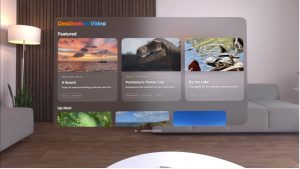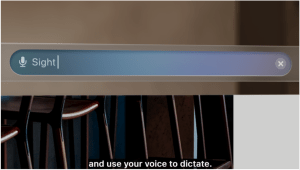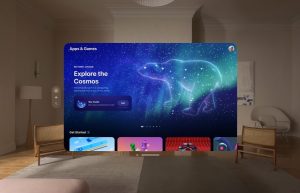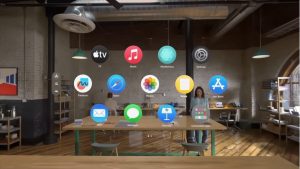Jesse Wiafe is a marketing executive and copywriter at Yodel Mobile, a leading mobile app marketing company. Jesse supports agencies in their growth efforts and regularly shares insights on the latest app marketing strategies to drive sustainable, long-term growth.
Today, Apple's visionOS operating system is at the forefront of technological innovation, revolutionizing the way we think about app development and user engagement. VisionOS is the operating system for Apple Vision Pro, a new addition to Apple's product catalog.
Apple Vision Pro is a wearable headset that removes the limitation of needing a screen to use your computer. This experience is called “spatial computing,” and the user's physical space is augmented with what's called an “infinite spatial canvas.” This means users can experience: Fully 3-dimensional user interface Gain physical control over your digital content with your eyes, hands, and voice.
Vision Pro headset officially launched in the US on February 2ndn.d., scheduled to be released worldwide in 2024. No official release date has been set for other countries yet, but analysts claim that Apple Vision Pro will be available internationally before WWDC in June 2024.
How will this new device impact mobile app marketing? Here at Yodel Mobile, we've started exploring new possibilities for how Apple Vision Pro can extend into the product experience of our clients' apps. Although the new visionOS App Store is in its early stages, we've noticed some clear opportunities and challenges for developers. For inside knowledge on how to tailor your app marketing techniques to fit Apple Vision Pro, see:
New VisionOS app store
Apple Vision Pro comes with its own dedicated App Store. This means new algorithms and new ways to optimize visibility and conversions. The new visionOS App Store has been launched with over 600 new apps. Since the initial release in February, this number has now increased to 1,000 native apps. This is a clear sign that Apple is pushing a new format for app developers. Developers have the option to opt-in their existing iOS apps to be available on visionOS to streamline this process, and Apple currently says there are more than 1.5 million compatible apps available on the headset. We are proud of
You'll quickly notice that the new App Store looks different than the iOS and iPad App Stores. The visual nature of the new Spatial Computing Headset means a focus is placed on the visual and creative aspects of the App Store to mirror the in-app experience. We also expect to rely heavily on visionOS App Store search for app discovery.
The visionOS app store operates with a different search format than iOS and iPadOS, which requires a more tailored approach to visibility optimization. It's worth noting that these findings pertain to the Apple Vision Pro's visionOS app store. Since its release, the visionOS App Store has been available on the web. The browsing experience on the web mimics the browsing experience of other Apple devices on the web. See below to learn how to optimize your ASO efforts.

Improving discovery in visionOS
During these early days, many developers struggled with poor visibility into their apps. Immersive reality specialist Tom Ffiske investigated the current state of search in Apple Vision Pro and shared his findings. Developers have commented that they find the discovery in the Apple Vision Pro App Store problematic. A notable issue is that no featured or top lists are clearly provided to users. This is a real limitation of the discovery opportunities typically seen on iOS. In addition, there are claims that Apple Vision Pro's analytics system is substandard due to bugs, technical issues, and lack of transparency. Some developers have commented that data regarding attribution of app downloads seems to be a major blind spot on Apple's part. Although the app's download source is visible, app developers are running into issues with incorrect attribution. Part of the blame also falls on new systems introduced for users to search.
New ways to search in Apple Vision Pro
You might think that IT spatial technology means that the Apple Vision Pro doesn't come with a physical keyboard. It introduces new systems and features for input and search that must be optimized for the native Apple Vision Pro app.
- Air typing: Users type in the air using a virtual keyboard, which many find difficult because there is no haptic feedback (no vibration or feel).
- How to look and pinch: The user performs pinch operations while looking at each character on the virtual keyboard.
- Voice dictation: The user just tells them what they want to write and the system does its best to generate the words.
This means ASO practitioners should consider optimizing a wide range of search methods. We believe that out of all these features, developers and their ASO strategists should optimize their metadata towards voice dictation as a natural approach for search in this new App Store. Masu. So far, many users have found voice dictation to be the fastest and most convenient search method when using visionOS.
A bias toward voice dictation can have a significant impact on your keyword optimization efforts. You may need to optimize your metadata to make voice search and dictation work better. This means considering qualitative factors such as slang, different accents, and acronyms.
With this in mind, localization is likely to play a bigger role in keyword optimization for visionOS. Developers pay more attention to different regions, languages, and cultural backgrounds to reach a wider audience, and strive to keep keywords current as languages and cultures continue to grow and change. There may be a need.
Just as you would with optimizing any other store, use analytics tools to track your keyword performance. Adjust your strategy based on the insights you gain. Also, pay attention to user feedback and reviews. Users often mention specific features or terms that become valuable keywords.
See the image below of voice search used as an example.

Know your vision OS metadata basics
The Apple Vision Pro App Store includes similar metadata elements on product pages as the iOS App Store, but is much more limited in scope.
- app name: Similar to iOS, Apple Vision Pro app names can only contain 30 characters. ASO rules (hierarchical importance) may not change.
- subtitles: Just like the app name, the subtitle has the same number of characters. General best practices will remain the same (i.e. using CTAs, leveraging important, high value/volume keywords, etc.)
- explanation: Apple suggests that the ideal description is a concise, informative paragraph followed by a short list of key features. The descriptive text is specific to the Apple Vision Pro product page. This is an opportunity to highlight features unique to the visionOS product experience.
Additionally, the nature of this new spatial technology requires developers to include app motion information in the app copy. This is a user safety measure.
Leverage Visual App Store creatives for your Apple Vision Pro product page
As mentioned above, the concept of spatial computing means that there will be a focus on the more visual and creative aspects of the App Store. When you download a new set of apps to your device, app icon The on the home screen will be circular, as opposed to the more cubic shape seen on other Apple devices.
App developers should consider optimizing their app icons for this new format or creating entirely new icons that fit the new creative requirements of the visionOS App Store. Icons typically clearly indicate apps that are natively optimized for Apple Vision Pro, and optimized apps have a new round icon shape when placed on the home screen. Anything that isn't optimized will still appear square. Old icons can be a negative signal to future app users. A lack of platform-related optimizations can appear to indicate a poor app experience. It is a good idea for all developers to follow the visionOS App Store best practices and creative guidelines to encourage downloads and usage.

Apple Vision Pro screenshots and previews
Icons aren't the only things that change in this environment. Screenshots and app preview videos are also key to communicating the Vision Pro app experience to potential users. These require a new approach to the Apple Vision Pro App Store listing. Apple emphasizes that screenshots must be captured or recorded directly from Apple Vision Pro. This way, the environment, functionality, and experience are conveyed as closely as possible to the in-app experience. App developers can also create simulations of Apple Vision Pro experiences, as long as they accurately represent their apps.
Apple also suggests that app owners can include human hands in screenshots and app previews if the app experience relies heavily on hands or specific gestures. We assume that Apple may tighten the review process. Screenshots containing hands that require creative license or without a clear reason may be rejected. In this case, Apple Vision Pro creative assets are much more functional for that purpose than iOS screenshots, which have more freedom to brand and promote. It's also unclear when native store features such as A/B testing will become available. This type of optimization effort in the visionOS store may be a while away. For more information, please visit Apple here. Guidelines page.

conclusion
Of all the big changes in mobile app marketing, Apple Vision Pro will undoubtedly create one of the biggest impacts we'll see in the current climate. The exact impact of the above effects will become clearer over time. Given the current price ($3499), it's difficult to see how quickly this new style of computing will be adopted by the masses. Stay tuned for future updates on how best to optimize visionOS algorithms in Apple Vision Pro.


